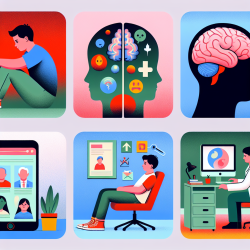Exploring the Connection Between Brain Development and Depression in Adolescents
As practitioners in the field of speech-language pathology, we are constantly seeking ways to improve outcomes for children. Recent research sheds light on the intricate relationship between brain development and depression in adolescents, emphasizing the importance of environmental factors. This blog post will delve into the findings of the study titled "Threat experiences moderate the link between hippocampus volume and depression symptoms prospectively in adolescence" and explore how practitioners can use these insights to enhance their practice.
The Study in Focus
The research conducted by Herzberg et al. (2024) aimed to identify neuroimaging risk markers for depression, specifically focusing on the hippocampus, a region of the brain associated with memory and emotional regulation. The study utilized data from the Adolescent Brain Cognitive Development (ABCD) study, involving 6,693 youth aged 9–10 years at baseline. The researchers sought to understand how environmental experiences, such as psychosocial threat, influence the relationship between hippocampus volume and depression symptoms over time.
Key Findings
- Hippocampus Volume and Depression: The study found that psychosocial threat moderated the association between right hippocampus volume and depression symptoms two years later. In low-threat environments, a negative association was observed, indicating that smaller hippocampal volume was linked to increased depression symptoms.
- Environmental Factors: The research highlights the importance of considering environmental heterogeneity when seeking risk markers for depression. The study suggests that hippocampus volume may not consistently correlate with depression symptoms in high-risk environments.
- Specificity of Effects: Interestingly, the study found that the interaction between psychosocial threat and hippocampus volume was significant only in youth who endorsed one or more depression symptoms at baseline.
Implications for Practitioners
Understanding the nuanced relationship between brain development and depression can inform therapeutic approaches. Here are some ways practitioners can leverage these findings:
- Environmental Assessment: Incorporate assessments of environmental factors, such as psychosocial threats, into evaluations. This can help identify children at higher risk for depression and tailor interventions accordingly.
- Targeted Interventions: Develop targeted interventions that address specific environmental stressors. For example, providing support and resources to families in high-threat environments may mitigate the impact on children's mental health.
- Collaboration with Educators: Work closely with educators to create supportive school environments that reduce psychosocial threats. This collaborative approach can enhance the overall well-being of students.
Encouraging Further Research
While this study provides valuable insights, it also highlights the need for further research. Practitioners are encouraged to explore additional dimensions of environmental experiences and their impact on brain development and mental health. By contributing to this growing body of knowledge, we can continue to improve outcomes for children and adolescents.
To read the original research paper, please follow this link: Threat experiences moderate the link between hippocampus volume and depression symptoms prospectively in adolescence.










